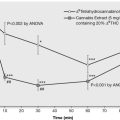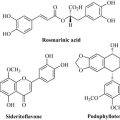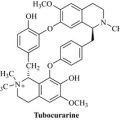Chapter 24 Ear, nose and orthopharynx
Infections of the ear, nose and throat are treated under medical supervision with antibiotics, but a number of soothing and antiseptic preparations from plant sources are available for use. Decongestants have already been discussed in Chapter 16.
The ear
Infections of the ear are treated with either topical or systemic antibiotics. However, the removal of wax from the ear is achieved with the aid of softening agents such as almond, arachis or olive oil (BNF), sometimes followed by ear syringing. For details of arachis oil, see Chapter 22.
The orthopharnyx
Thymol 
Thymol (Fig. 24.1) was originally extracted from thyme (Thymus spp.) and is present in many oils, including ajowan, but is now more easily synthesized chemically. It is antiseptic, deodorizing and antiinflammatory and is widely used in dental products (e.g. compound thymol glycerin). Thymol causes irritation in high concentrations when applied externally, and should not be swallowed in significant amounts. Normal doses associated with the herb do not normally cause problems.
Peppermint oil, Mentha × piperita L. (Menthae piperitae aetheroleum) 
Peppermint oil is antiseptic, deodorizing and antiinflammatory and is widely used in skin and dental products. Other species of mint, such as spearmint, are also used for the same purpose (for botanical and chemical details, see Chapter 14).
Constituents
The major constituents are menthol (30–55%) and menthone (14–32%), with isomenthone (2–10%), menthofuran (1–9%), menthyl acetate (3–5%), 1,8-cineole (6–14%), limonene (1–5%), pulegone (not more than 4.0%) and carvone (not more than 1.0%). Menthol (Fig. 24.2) can cause irritation in high concentrations.
Sage, Salvia officinalis L. (Salviae folium) 
The genus Salvia is one of the largest of the family Lamiaceae and many of its species, especially those rich in essential oil, have pharmaceutical uses. This common garden plant (garden sage) and culinary shrub has conspicuous blue flowers and relatively large leaves (3–5 cm long, 1–2.5 cm broad), which are oblong or lanceolate, rounded at the base and at the apex, and crenulate at the margin. The young leaves especially are covered with a white layer of fine hairs. The leaves have a characteristic uneven upper surface and prominent lower venation. The taste and odour are characteristic, pungent and aromatic. Sage is a popular culinary herb. S. triloba L.f. is also rich in essential oil and has similar topical uses as S. officinalis (see also Chapter 16, p. 232).
Therapeutic uses and available evidence
The use of sage leaf, in the form of a tea used as a gargle, is traditional for soothing inflammation of the mucous membranes of mouth and throat. Rosmarinic acid is well known for its antiviral and antiinflammatory effects, sage essential oil is antibacterial and antifungal, and an aqueous extract of sage leaf has been shown to have analgesic and antiinflammatory effects in rats, supporting this use of sage. In the doses used for mouthwashes it is generally considered to be safe. A throat spray containing echinacea and sage was recently compared to a chlorhexidine and lidocaine spray in a multicenter, randomized, double-blind, double-placebo controlled trial involving 154 patients with acute sore throats. They used two puffs every 2 hours, up to 10 times daily until they were symptom-free, for a maximum of 5 days. The main outcome measure was the comparison of response rates during the first 3 days, a response being defined as a decrease of at least 50% of the total symptoms compared to baseline. The echinacea/sage treatment showed similar efficacy to the chlorhexidine/lidocaine spray during the first 3 days, i.e. 63.8% in the echinacea/sage group and 57.8% in the chlorhexidine/lidocaine group. For all assessments of efficacy by the physician and patient, no difference between the two treatments was seen, and both were very well tolerated (Schapowal et al 2009).
Clove, Syzygium aromaticum (L.) Merr. & L.M. Perry (Caryophylli flos) 
Constituents
The buds are very rich in essential oil (15–20%), consisting mainly of eugenol (Fig. 24.3), usually 85–90%, and numerous minor constituents, including acetyl eugenol, α- and β-caryophyllene, methyl salicylate. Tannins such as eugeniin, casuarictin, tellimagrandin I, and flavonoids, are found in the plant material but not in the oil.
Therapeutic uses and available evidence
Clove oil is used for the symptomatic relief of toothache and is a constituent of many dental preparations. The oil is useful in the treatment of inflammation of the mucous membranes of mouth and throat. It has antiseptic, antispasmodic, antihistaminic and anthelmintic properties, many of which are due to the eugenol content. Eugenol inhibits prostaglandin synthesis and the metabolism of arachidonic acid by human polymorphonuclear leukocytes, inhibits smooth muscle activity in vitro and is antiinflammatory (for review, see Chaieb et al 2007). Clove extracts are used in cosmetics and perfumery.
British National Formulary. Published biannually by the BMJ Group and the Pharmaceutical Press. See also http://bnf.org/bnf/index.htm
Chaieb K., Hajlaoui H., Zmantar T., et al. The chemical composition and biological activity of clove essential oil, Eugenia caryophyllata (Syzygium aromaticum L. Myrtaceae): a short review. Phytother. Res.. 2007;21:501-506.
Schapowal A., Berger D., Klein P., Suter A. Echinacea/sage or chlorhexidine/lidocaine for treating acute sore throats: a randomized double-blind trial. Eur. J. Med. Res.. 2009;14:406-412.








